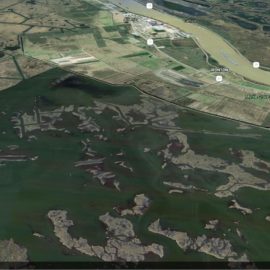
On the other side of the Mississippi from all of the industry from St John the Baptist Parish, St James Parish, specifically Wallace, is slated for a grain elevator sponsored by a surprising source.
For decades, Wallace residents watched as industrial plants sprouted across the Mississippi River on St. John the Baptist Parish’s east bank. Although the odors and dust drift across the river to their homes, their rural, mostly Black community sits amid a bucolic landscape unbroken by the towering steel structures. In March, however, plans for a new 56-silo grain terminal just a few hundred feet from a neighborhood caught many residents by surprise – and spurred some into action. They launched a campaign, known as Stop the Wallace Grain Elevator, out of fear of any additional air pollution and anger over a lack of community input. Oddly enough, that put them on the opposite side of a project linked to one of the darlings of the environmental, social and corporate governance movement: Christopher James, who ran a successful campaign in May to install new ExxonMobil board members in hopes of reducing the company’s carbon footprint. Now the group is touting what it deems as its first victory: The Louisiana Department of Natural Resources has agreed to reconsider its decision to exempt the project from applying for a coastal use permit, which carries with it a requirement that the department hold a public hearing on the project. The group’s leaders hope the decision leads to the forum they want to air their objections. “We’re happy someone took our concerns seriously because our local representatives have refused to answer our questions or listen to our concerns,” said Joy Banner, a Wallace native who began organizing others alongside her sister, Jo.
nola.com
This change of heart is just procedural and is no guarantee the project is stopped.
The state’s about-face is a procedural move; it might not ultimately lead to a public hearing, much less kill a project with estimated construction costs of as much as $400 million. Nonetheless, it illustrates the growing influence of the environmental justice movement in the heavy industrial corridor along the Mississippi between New Orleans and Baton Rouge. Too, the conflict is reminiscent of a fight in the early 1990s with Formosa Plastics Corp., which is now looking to locate in St. James Parish. Thirty years ago, the Taiwan-based company sought to build the world’s largest wood pulp and rayon plant at Wallace but faced stiff opposition from residents. The grain terminal is proposed by Greenfield Exports LLC, which incorporated in 2019 and is owned by Medlock Investments. Medlock manages the assets of hedge fund manager-turned-environment activist James, who founded Engine No. 1 and campaigned to change ExxonMobil’s board. Medlock also backed the development of the Pin Oak Oil Terminal on St. John’s east bank in 2012.
The objection hinges on the initial submission by the plant.
The company initially told the Department of Natural Resources that all but 5 acres of its 248-acre Wallace site stands more than 5 feet above sea level. That was the basis for the department determining it was exempt from a coastal use permit. Banner and other residents, joined by the Concerned Citizens of St. John and the Louisiana Bucket Brigade, intervened in August. They objected to a lack of public notice before the state made its decision. In response, Greenfield provided a new land survey showing about 20 acres below 5 feet. The new survey was produced in a gesture of transparency, said the company’s attorney, Louis Buatt. Natural Resources Secretary Thomas Harris reopened deliberations, remanding the company’s application to the coastal office for review and to consider whether a public hearing is needed. Department spokesperson Patrick Courreges said Tuesday the office is waiting for more information from Greenfield. Generally, the agency wouldn’t have a basis to hold a hearing if a project is exempt from coastal rules. “Coastal Management would not make a call on public hearing until we get that information, and we wouldn’t want to speculate on whether we will or not before we’ve seen the data,” Courreges said.
The feeling is that a hearing would be held but the best place to put the health and safety problems to the front would be in the COE permit process.
Greenfield staff said they think the project will remain exempt, as most of the land remains above 5 feet. Instead, they said residents’ health and safety concerns would likely be heard during the U.S. Army Corps of Engineers’ permitting process, which considers a wider range of issues, including environmental justice, than the state does. Expected to hold as much as 8 million metric tons of grain, Greenfield’s elevator would provide 100 jobs paying an average of $75,000 a year and 500 “indirect jobs,” the company said. Despite the close proximity to homes, the company chose the location for its deepwater and railroad access, and plans to build “a state-of-the-art” grain terminal to catch dust “at every point possible.” “The development of the Wallace grain property is about transitioning to a cleaner more sustainable economy, and we realize that requires community involvement,” the company said.
The company desires to expand the economic base away from just oil and chemicals.
Greenfield said it wants to help the River Parishes diversify the region’s tax base beyond oil refineries and chemical plants. Almost every elected local, state and federal official with interests in the region has lined up behind the project, offering letters of support. St. John Parish President Jaclyn Hotard said tax revenue from new projects such as the grain elevator pays for the parish’s infrastructure and offers well-paying jobs. “We hope projects like this will not only encourage our young residents to stay but attract new families to the area to grow the parish,” she said. But the Banner sisters don’t see the grain elevator’s silos – some expected to rise more than 200 feet in the air – as the path forward. They worry about living so close to a hulking business that would be permitted to emit as much as 37 tons of fine particulate matter per year. At less than 2.5 micrometers wide, these particles can be inhaled, enter the bloodstream and cause heart and lung issues in people with chronic exposure. The dust is also highly combustible if it accumulates, leading to explosions. More than 150 other residents who live within a mile of the site agree with the Banners. They signed letters in opposition, drawing the attention of environment activists such as retired Army Lt. Gen. Russel Honoré and the Sunrise Movement. Many of the residents in the Banner’s hometown of 1,200 descend from people who were enslaved on nearby plantations. The Banners’ ancestors toiled on the Whitney Plantation, for example. “This land is sacred,” Joy Banner said. “The way in which these facilities come into our community is a game plan of how they work and how they’ve been working for decades.”
The company does not object to a public hearing as they have interacted with the parish’s citizens in other ways.
Greenfield said it does not oppose a public hearing for its project or community engagement, having already met with more than 500 community members and delivered aid to residents after Hurricane Ida, although a meeting with Stop the Wallace Grain Elevator hasn’t occurred. Greenfield and officials of the Port of South Louisiana, which exports more grain than any U.S. port, say the group’s views are in the minority. “Greenfield has heard from many residents who are not opposed to this project, and they continue to reach out to local residents to discuss the project,” said Julia Fisher, the port’s director of business development. “A small but vocal group may not accurately reflect the majority opinion in this case.”
The problem facing many of the communities is that they need jobs to keep people to stay but the question is what kinds of jobs. There are no technology one there and so it is heavy industry. It does not help that the Mississippi River is heavily industrialized in this area.



